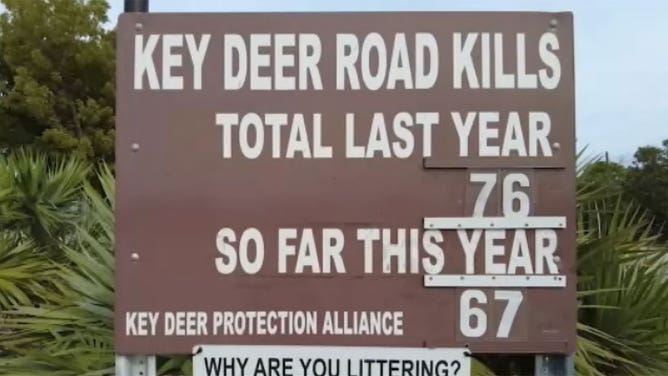Climate change adds another challenge to Key deer’s fight for survival
‘To lose them from their native habitat would be an incredible loss,’ conservationist says
Deer unique to Florida Keys are in danger
Key Deer are a smaller type of deer found only on some islands of the Florida Keys. Today a rise in sea levels is introducing salt into places where they would normally drink freshwater and eat, minimizing the land they can use.
BIG PINE KEY, Fla. – A species of deer native to the Florida Keys has been fighting for survival for decades. Now, climate change is adding another hurdle to the animal’s existence.
The Key deer is a smaller subspecies of the white-tail deer and is sometimes called the "toy deer." On average, they only stand between 2 and 3 feet tall and grow to between 55 and 75 pounds. They used to inhabit many of the islands in the archipelago, but now they number fewer than 1,000 and are primarily found on Big Pine Key – home of the National Key Deer Refuge.
"In the early 1900s, where Key deer were kind of hunted with reckless abandon … there wasn't a whole lot of wildlife regulations back then," said refuge Park Ranger Kristie Killam. "(When) people started witnessing the demise of the Key deer population, they think (there were) maybe 25 to 50 Key deer remaining."
The refuge was created in 1957 and protects more than 84,000 acres across the Lower Florida Keys. This has given the deer great food and water sources in the higher elevations of the island.

Three deer graze roadside in the Florida Keys.
(FOX Weather)
"The grasses and the wildflowers … the low-ground covers are the kinds of things that they eat," said Chris Bergh, the South Florida program manager for The Nature Conservancy. "Especially, right after a wildfire or prescribed fire. The shrubs … it kills the top of the plant and then it regrows from the roots, and all that new growth is like tasty young salad greens. That's very nutritious."
In the lower elevations, however, it can be more famine than feast. High tides are bringing saltwater ashore, killing the vegetation and filling up ponds that normally contain freshwater that the deer drink.
Local conservationists said Hurricane Irma in 2017 pushed a lot of seawater ashore and took out many of the freshwater sources upon which the animals rely.
"The animals left. They had to leave," said Jan Svejkovsky, lead scientist at the local conservation group Save Our Key Deer. "They lost a pretty nice big chunk of their former habitat. And then also the few deer, for example, that are left in this area are completely dependent on human sources of drinking water."
With climate change leading to rising sea levels, the deer face even more habitat loss.
One of many adversities
Climate change is just one of the many circumstances that are pushing Key deer to the brink of extinction.
The hooved mammal was one of the first animals to be placed on the endangered species list when the Endangered Species Act became law in 1973.
Car accidents have killed more than 70 of the deer last year, and this year isn’t far behind.

A sign shows how many Key deer have been hit by vehicles in 2020 and 2021.
(FOX Weather)
"The problem is that people don't even know the deer exist there, so they're not looking for deer at all," Svejkovsky said. "They don't consider the fact (that it is) even possible that they're going to collide with a deer."
According to the National Wildlife Federation, the animals also face disease, illegal hunting by humans and loss of habitat from the development of coastlines and floodplains.
"By the end of the century, almost certainly, there won't be enough fresh water for the deer, so the wildlife managers can bring in water," Bergh said. "That'll only buy another, you know, maybe a century if we're lucky."
For now, government officials and local conservationists are continuing their efforts to protect the deer who call the Florida Keys home.
"You know, these are wild native animals that they're adapted to this particular place," Bergh said. "To lose them from their native habitat would be an incredible loss."
